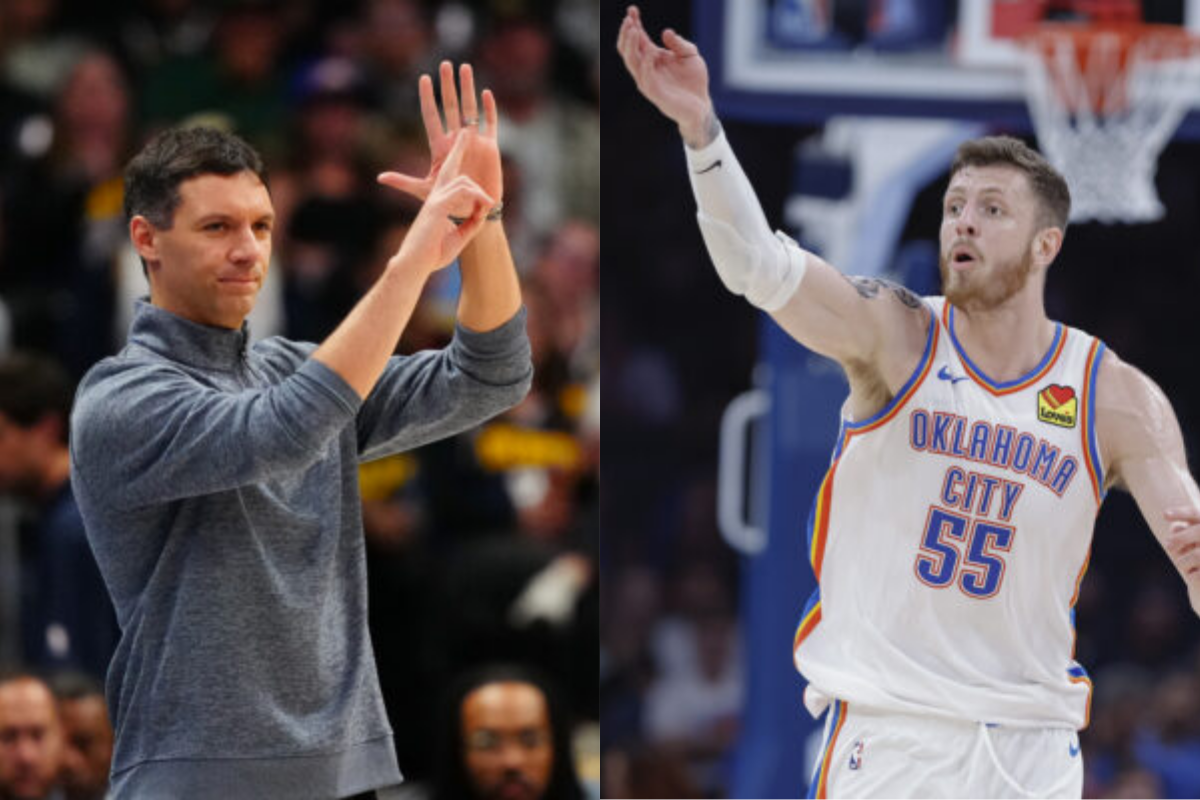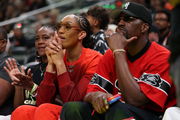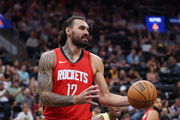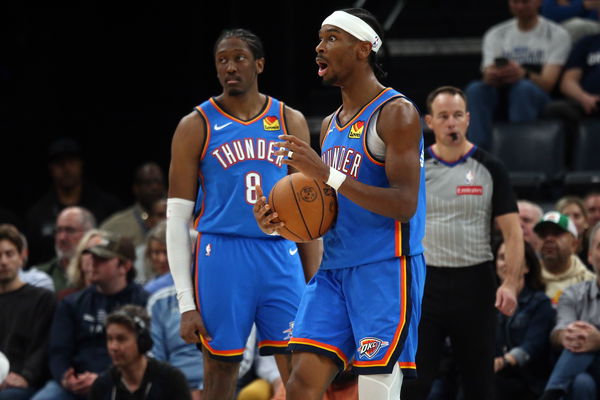
Imago
Credit: Imagn Images

Imago
Credit: Imagn Images
Sometimes the NBA Finals feel something akin to a high-stakes chess match, where one questionable move can be the difference between a championship parade and a summer full of “what ifs.” And after the Oklahoma City Thunder’s stunning, last-second 111-110 loss to the Indiana Pacers in Game 1, everyone is pointing to coach Mark Daigneault’s very first move of the series as a potential game-changing blunder. He made a surprise change before the game even started, and according to some experts, it sent a message to the Pacers that the Thunder, not the underdogs from Indy, were the ones who were already nervous.
Watch What’s Trending Now!
For the first time in these entire 2025 playoffs, Daigneault, the guy who’s been pushing all the right buttons, decided to switch up his starting lineup. He benched his big man, Isaiah Hartenstein, in favor of Cason Wallace. Why? As Daigneault explained it after the game, he wanted “another perimeter guy” on the floor to deal with the Pacers’ speedy backcourt of Tyrese Haliburton and Andrew Nembhard. On paper, okay, you can kind of see the logic. You want to match speed with speed.
But as ESPN’s Brian Windhorst masterfully pointed out, a move like that, on a stage this big, sends a powerful psychological signal. “When you start the exact same starting lineup for the first three rounds of the playoffs, and then you change your starting lineup to start the Finals, you can give whatever statement you want… you are indicating to the other team that you are bending to them,” Windhorst said. Boom. That’s the whole story right there. Before the Pacers even had a chance to prove that OKC’s size was a problem, Daigneault conceded that it might be. He blinked first, and you can bet the Pacers noticed.
ADVERTISEMENT

USA Today via Reuters
Mandatory Credit: Alonzo Adams-USA TODAY Sports
For a stretch, Mark Daigneault’s strategy looked like a masterstroke. The Thunder had built a 15-point lead in the fourth quarter, and it felt like they were cruising toward a statement win. But as they’ve shown all postseason, the Pacers don’t go quietly. The turning point came when Daigneault went small again down the stretch, pulling both of his centers. Indiana wasted no time capitalizing. They lit it up from deep, and Pascal Siakam began dominating the offensive boards, exploiting OKC’s undersized lineup.
Evident by two of the most decisive plays coming from Indiana, outside of Haliburton’s game-winner. First, the offensive rebound for a putback layup, and then a block on SGA’s shot attempt.
ADVERTISEMENT
Postgame, Daigneault remained composed, brushing off concerns about the decision. “We’ve been pretty fluid with the lineup throughout the course of the season,” he said. “That’s why we do it during the regular season, so that it’s not Earth shattering when we do it.” As for Isaiah Hartenstein, he took the high road, adding, “I am here to do whatever is best for the team. I trust Mark.”
But while the Thunder are saying all the right things about learning from the loss, you have to wonder what message the Pacers received. The Thunder’s first big strategic move of the NBA Finals was a reactive one, a concession to Indiana’s style. And now, it’s the Pacers who are heading into Game 2 with a massive boost of confidence and a 1-0 series lead.
ADVERTISEMENT
OKC’s rebound relationship: It’s complicated
Alright, OKC lost game 1. Fine. It’s not game over yet because they’ve lost a Game 1 at home before (against Denver) and came back to win the series. So the question now is: Where do we go from here?
Let’s start with the most glaring issue: rebounding. Or, the complete lack of it. Daigneault’s decision to limit Isaiah Hartenstein’s minutes caused OKC to get absolutely crushed on the glass. The Pacers grabbed 13 offensive rebounds, and it felt like every single one led to a back-breaking play. There was one sequence in the second quarter where Andrew Nembhard missed a free throw, but Pascal Siakam just out-hustled everyone to get the ball back and score. That one play was a perfect snapshot of the problem. Without their best rebounder in Hartenstein on the floor, the Thunder were giving up way too many second chances.
ADVERTISEMENT
Then there was the offense. Yes, SGA was spectacular—but beyond him, OKC looked completely out of rhythm. The number of rushed, zero- or one-pass possessions was jarring. Gone was the usual ball movement and tempo that had defined their offense all season; in its place was isolation-heavy, stagnant basketball. Hartenstein’s absence didn’t just hurt their defense—it clogged up the offensive flow, making it even tougher to get SGA and Jalen Williams clean looks.
Top Stories
A’ja Wilson, Bam Adebayo Issue Strong Statement Against Rachel Nichols’ Question About Couple’s Privacy

Caitlin Clark Surpasses LeBron James, Stephen Curry With 136,000 PSA Announcement

NBA World Turns On Victor Wembanyama After Subtle Dig at Shai Gilgeous-Alexander, OKC

Respect Pours In for Shaquille O’Neal, Charles Barkley After $200,000 Announcement

Who Is Steven Adams’ Girlfriend Kayla? Everything to Know About Rockets’ 6’11 Star’s Romance Life

And speaking of Williams and Chet Holmgren, the Thunder’s second and third most vital scoring options? They were essentially absent. The duo combined to shoot just 8-of-28 from the field, with Holmgren managing only six points on 2-of-9 shooting. Shaq even alluded to the center, stating, “Chet had a horrible game,” he looked hesitant, almost passive, on both ends of the floor—a tough look in such a pivotal game.

Imago
Feb 8, 2025; Memphis, Tennessee, USA; Oklahoma City Thunder guard Shai Gilgeous-Alexander (2) reacts during the second quarter against the Memphis Grizzlies at FedExForum. Mandatory Credit: Petre Thomas-Imagn Images
So, what’s the blueprint for Game 2? It’s not rocket science, as SGA himself said. First, they have to figure out the Hartenstein situation. His screening and rebounding are just too important to their success. But that means Hartenstein himself has to “play better” defensively and not get lost guarding Indiana’s stretch bigs on the three-point line, which is why he was taken out in the first place. Second, the offense needs to get back to moving the ball. No more quick, selfish jumpers. Run your sets, get SGA and Williams moving downhill, and let Holmgren get involved as a finisher, not just a bystander.
ADVERTISEMENT
The biggest reason for optimism in OKC? Holmgren and Jalen Williams would both be way better going forward. It’s hard to imagine them both having such rough nights again. This Thunder team hasn’t lost back-to-back games these entire playoffs. They’ve shown they can take a punch, learn from it, and come back throwing haymakers. As Coach Daigneault said after the loss, “We got to learn from it… get ourselves to zero, as we always do. That’s a habit that hopefully we’ve formed.” Game 2 is now a massive test of that habit, a chance to prove that the Game 1 collapse was just a fluke, not a fatal flaw.
ADVERTISEMENT
ADVERTISEMENT
ADVERTISEMENT
ADVERTISEMENT

